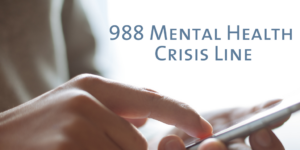988 is the new way to reach the Suicide and Crisis Lifeline! The three-digit number, which became available as of July 16, is easy to remember and provides access to help during a mental health crisis. Mental Health Minnesota’s Executive Director, Shannah Mulvihill, spoke with WCCO Radio’s Jason DeRusha during drive time on Friday, July 15 about the importance of 988, what it is, and what we need to do next to ensure that Minnesota calls get answered here in our state. Listen to the interview here.
News
In 2023, Mental Health Month Encourages Us to “Look Around, Look Within”
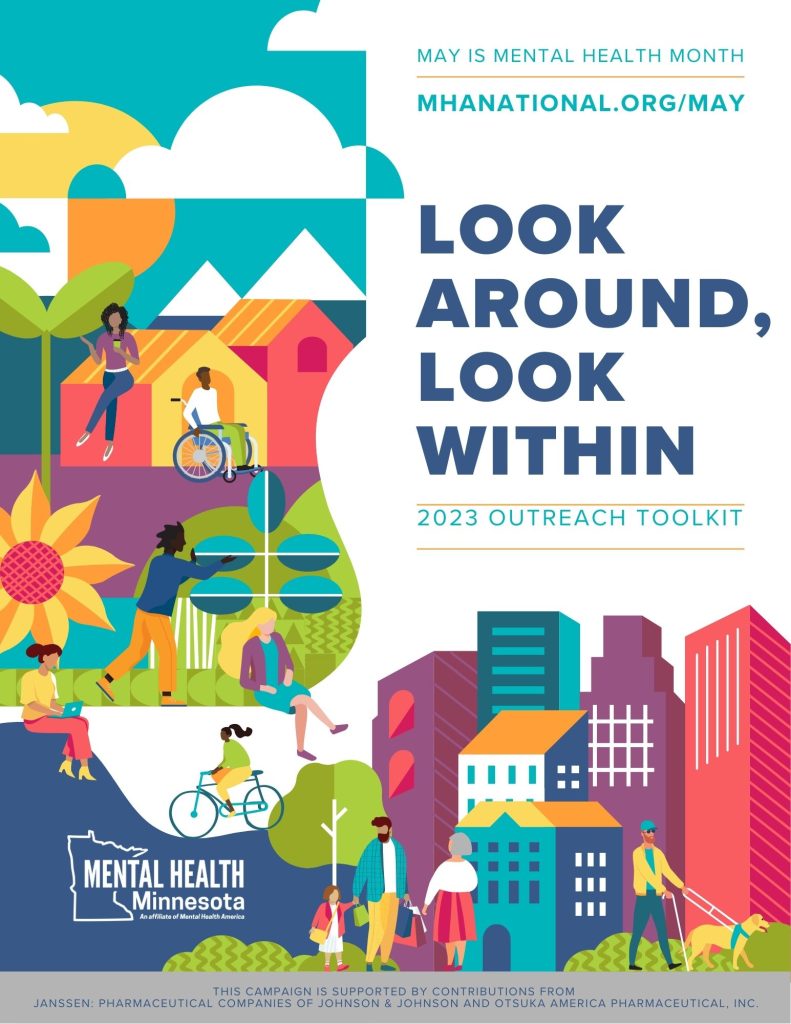
Take a moment to consider your surroundings. Do you feel safe? Do you have access to health care and grocery stores? Does your home support you, both physically and mentally?
This Mental Health Month, challenge yourself to look at your world and how different factors can affect your mental health.
Where a person is born, lives, learns, works, plays, and gathers, as well as their economic stability and social connections, are part of what is called “social determinants of health” (SDOH). The more these factors work in your favor means you are more likely to have better mental well-being. However, when it seems like the world is working against you, your mental health can suffer.
While many parts of your environment can be out of your control, there are steps you can take to change your space and protect your well-being.
• Work toward securing safe and stable housing: This can be challenging due to finances, age, and other reasons, but there are a few things you can try, such as reaching out to state/local agencies to secure housing, removing safety hazards in the home, or finding another space (such as a community center or friend’s home) where you can get the comfort you are missing at home.
• Focus on your home: Consider keeping your space tidy, sleep-friendly, and well-ventilated. Surround yourself with items that help you feel calm and positive.
• Create bonds with your neighborhood and community: Get to know the people living around you, join or start neighbors-helping-neighbors groups, and support local businesses to challenge gentrification.
• Connect with nature: Hike in a forest, sit in a city park, bring a plant inside, or keep the shades open to absorb natural light.
If you’re taking steps to improve your surroundings but are still struggling with your mental health, you may be experiencing signs of a mental health condition. Take a free online mental health screening at to help you figure out what is going on and determine next steps.
The world around us can be both positive and negative – bringing joy and sadness, hope and anxiety. Learn more with Mental Health America’s 2023 Mental Health Month toolkit, which provides free, practical resources, such as how an individual’s environment impacts their mental health, suggestions for making changes to improve and maintain mental well-being, and how to seek help for mental health challenges.
May is Mental Health Month: Introducing RELATE
RELATE Online Chat Launches: New Peer-To-Peer Support Service for Youth Ages 13-25
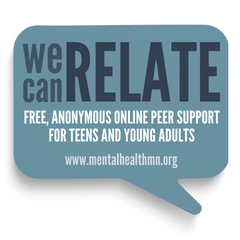
Since the start of the pandemic, more and more people are talking about mental health. An increasing number of folks are starting to see it for what it is: one important component of your overall health and well-being, just like your physical health. But mental health conditions, resources, and conversations can still feel complicated and out of reach, especially if you don’t know where to turn for help. If you’re a young person, ages 13-25, you may also feel like no one can relate to what you’re going through.
And with youth mental health reaching crisis levels, we knew we needed to act. This Mental Health Month, we’re excited to launch our new RELATE service on May 2, 2022 – an online chat run by young adult volunteers who know what it’s like to deal with their own mental health issues. They can relate and they share their experiences and provide compassionate, confidential and anonymous peer-to-peer support and hope for those looking for help. Learn more
But no matter your age or demographics, it’s important to look for common, specific warning signs of mental health conditions or crises. This Mental Health Month, we’re reminded how people are learning about mental health topics for the first time. Having a widespread understanding of the topic can help you be more informed if you or someone you know is experiencing a mental health condition or crisis.
Around half of the people in the U.S. will meet the criteria for a diagnosable mental health condition at some point in their life, so everyone should know what to look out for. Everyone should have the support needed to thrive. Communities that have been historically and presently oppressed face a deeper mental health burden because of the added impact of trauma, oppression, and harm.
There’s often no one single cause for a mental health condition. Instead, there are many possible risk factors that can influence how likely a person is to experience a mental health condition or how serious the symptoms may be.
Some risk factors for mental health conditions include: trauma, which can be a one-time event or ongoing; your environment and how it impacts your health and quality of life (also known as social determinants of health like financial stability and health care access); genetics; brain chemistry; and your habits and lifestyle such as a lack of sleep.
Of course, understanding the risk factors for a mental health condition can be more difficult when it’s your own mental health. Take time to ask yourself about your thoughts, feelings, and behaviors to see if this is part of a pattern that may be caused by a mental health condition.
Here are some questions to get you started:
- Have things that used to feel easy started feeling difficult?
- Does the idea of doing daily tasks like making your bed now feel really, really hard?
- Have you lost interest in activities and hobbies you used to enjoy?
- Do you feel irritated, possibly to the point of lashing out at people you care about?
Our society focuses much more on physical health than mental health, but both are equally important. If you are concerned about your mental health, there are several options available.
You are not alone – help is out there, and recovery is possible. It may be hard to talk about your concerns, but simply acknowledging to yourself that you’re
struggling is a really big step.
Taking a screen at mentalhealthmn.org/work/screening can help you to better understand what you are experiencing and get helpful resources.
At Mental Health Minnesota, we have free, accessible resources available to help youth, families and adults get support for any mental health concern or diagnosis before #B4Stage4 or before a crisis:
- RELATE: New, peer-to-peer online chat support service run by young adults for youth ages 13-25 launching May 2, 2022
- Minnesota Warmline – Certified Peer Support Specialists offer free support to anyone struggling with mental health concerns
- Mental Health Helpline – Mental health resource, information and local provider referrals
Fact Sheets: Back To Basics – Practical Mental Health Information
- MHM 2022 Back to Basics: FACT SHEET Starting to Think About Mental Health (PDF)
- MHM 2022 Back to Basics: FACT SHEET What Plays a Role in Developing Mental Health Conditions (PDF)
- MHM 2022 Back to Basics: FACT SHEET Maintaining Good Mental Health (PDF)
- MHM 2022 Back to Basics: FACT SHEET Recognizing When You Need Help with Your Mental Health (PDF)
- MHM 2022 Back to Basics: FACT SHEET What to Do When You Need Help (PDF)
- MHM 2022 Back to Basics: FACT SHEET Where to Go (PDF)
- MHM 2022 Back to Basics: FACT SHEET Terms to Know (PDF)
Mental Health Minnesota Earns Charities Review Council Meets Standards Seal
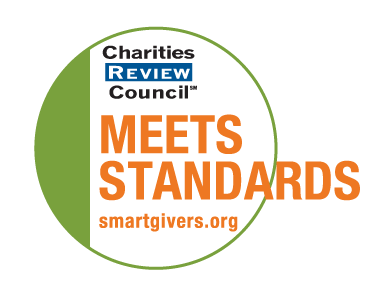
Mental Health Minnesota recently received Charities Review Council’s Meets Standards® seal, a visual marker on nonprofit strength. Nonprofit organizations, such as Mental Health Minnesota, earn the Meets Standards® seal by voluntarily participating in Charities Review Council’s Accountability Wizard® review process.
The only web-based product of its kind, the Accountability Wizard® is a time-tested tool, elevated by nationally recognized capacity building practitioners and philanthropic thought leaders. The Accountability Wizard® is based on Charities Review Council’s 25 Accountability Standards®, a balance of nonprofit sector promising practices, public expectations, and legal requirements, representing the shared expectations between donors and nonprofits.
The review process examined four key areas: Public Disclosure, Governance, Financial Activity, and Fundraising. As a result, Mental Health Minnesota has aligned its practices, policies and procedures to widely accepted standards of accountability, leading our organization to greater strength, efficacy and to the achievement of the Meets Standards® seal. By participating in the Accountability Wizard® review process, Mental Health Minnesota demonstrates responsibility, integrity and transparency to donors as well as the general public. Mental Health Minnesota’s full review report is available online at www.smartgivers.org, and the organization will also be listed in Charities Review Council’s bi-annual Smart Giver Newsletter.
Mental Illness Awareness Week – October 3-10, 2021
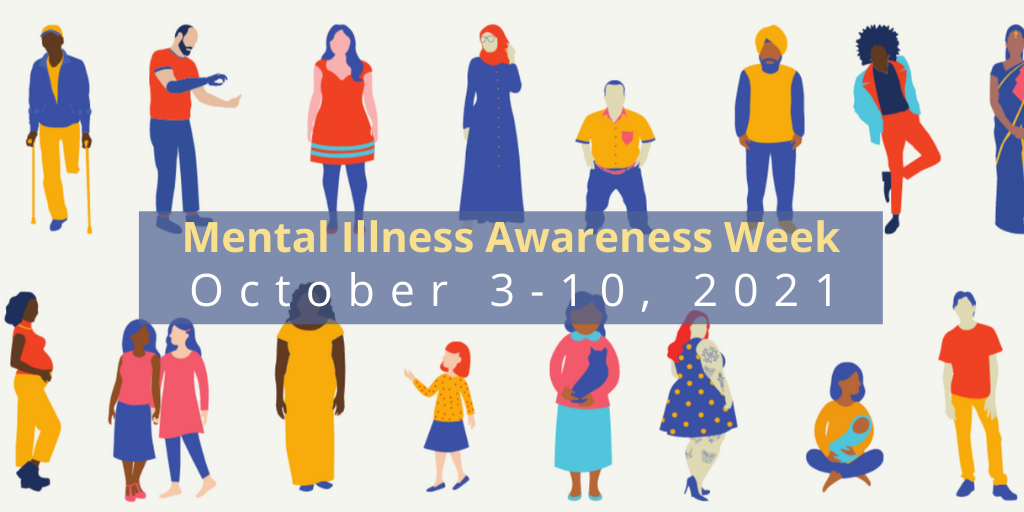
This year for Mental Illness Awareness Week, October 3-10, 2021, we are joining Mental Health America (MHA) to raise awareness of mental health conditions that are often misunderstood. MHA created this theme after listening to our community, where many felt that their diagnoses weren’t at the forefront of the mental health conversation.
These conditions include Obsessive-Compulsive Disorder (OCD), Attention-Deficit/Hyperactivity Disorder (ADHD), Borderline Personality Disorder (BPD), Seasonal Affective Disorder (SAD), Dissociative Disorders, Paranoia and Delusional Disorders, and other conditions that don’t fit into specific diagnoses – known as Not Otherwise Specified (NOS).
The week culminates in World Mental Health Day on October 10. This year’s theme, Mental health care for all: let’s make it a reality, offers an opportunity for our global community to reflect on how we can make mental health services and resources accessible to all.
At Mental Health Minnesota, we have free, accessible resources available to help children, families and adults get support for any mental health concern or diagnosis before #B4Stage4 or before a crisis:
- Minnesota Warmline – Certified Peer Support Specialists offer free support to anyone struggling with mental health concerns
- Mental Health Helpline – mental health resource, information and local provider referrals
- 833-HERE4MN – licensed mental health providers offer free support to anyone struggling during the pandemic
Obsessive-Compulsive Disorder (OCD)
PRESENCE OF OBSESSIONS:
- Common obsessions include: contamination, losing control, physical harm, symmetry, unwanted sexual thoughts
- Intrusive and unwanted thoughts, urges, or images that a person can’t stop thinking about
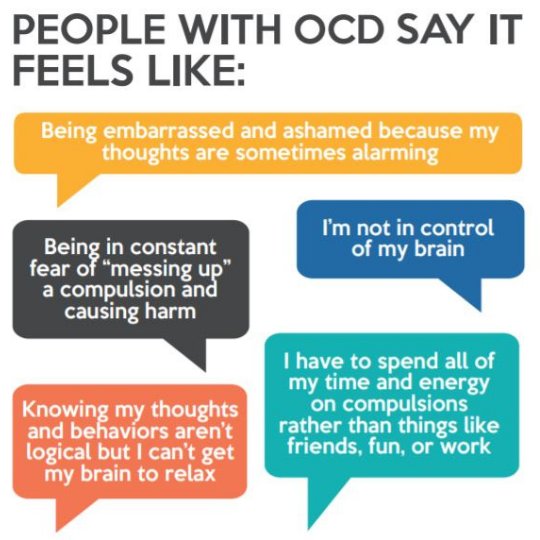
PRESENCE OF COMPULSIONS:
- Repetitive behaviors or mental acts that a person feels driven to do, either to reduce an obsession or according to rigid rules
- Common compulsions include: washing and cleaning, checking, repeating, counting, reciting a word or phrase
DISRUPTION:
- Thoughts and/or behaviors associated with OCD are time-consuming and interfere with daily life
RELATED DISORDERS INCLUDE:
- Body dysmorphic disorder
- Hoarding disorder
- Trichotillomania (hair-pulling)
- Excoriation (skin-picking)
Attention-Deficit/Hyperactivity Disorder (ADHD)
SIGNS AND SYMPTOMS OF ADHD
People who have ADHD may have all or some of the following signs and symptoms:
In Children:
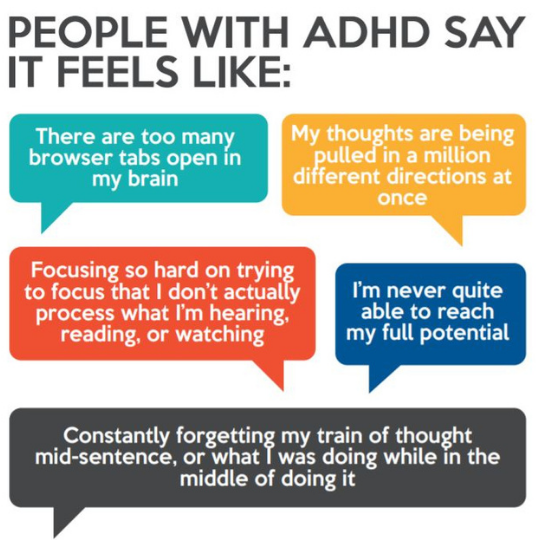
- Inattention
- Difficulty following instructions
- Difficulty focusing on tasks
- Frequently losing or misplacing things at school and home
- Forgetfulness
- Easily distracted or has difficulty listening
- Lacking attention to detail or making careless mistakes
- Disorganization
- Often does not complete homework or tasks
- Hyperactivity-Impulsivity
- Is fidgety
- Runs or climbs inappropriately
- Talks excessively
- Difficulty playing quietly
- Always on the go
- Blurts out answers
- Has trouble waiting their turn
- Often interrupts
In adults:
- Distractibility
- Disorganization
- Forgetfulness
- Procrastination
- Chronic lateness
- Chronic boredom
- Anxiety
- Depression
- Low self-esteem
- Mood swings
- Employment problems
- Restlessness
- Substance abuse or addictions
- Relationship problems
- Rejection sensitive dysphoria (RSD)
Borderline Personality Disorder (BPD)
SIGNS AND SYMPTOMS OF BPD
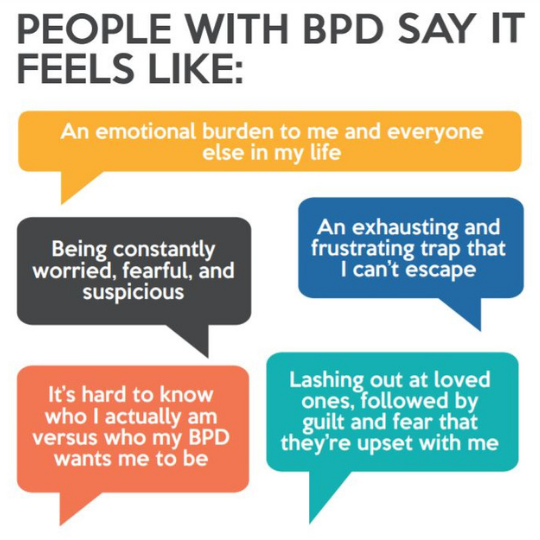
- Frantic efforts to avoid real or perceived abandonment
- Intense mood swings lasting hours or days
- Impulsivity and/or risky behavior
- Unstable intense relationships
- Self-injurious or suicidal threats or behaviors
- Acts of self-sabotage
- Chronic feelings of emptiness
- Inappropriate, intense anger and rage
- Unstable sense of self, including changing goals and values
- Dissociation and feelings of detachment
- Trouble trusting others
Disassociative Disorders
SIGNS AND SYMPTOMS OF DISASSOCIATIVE DISORDERS
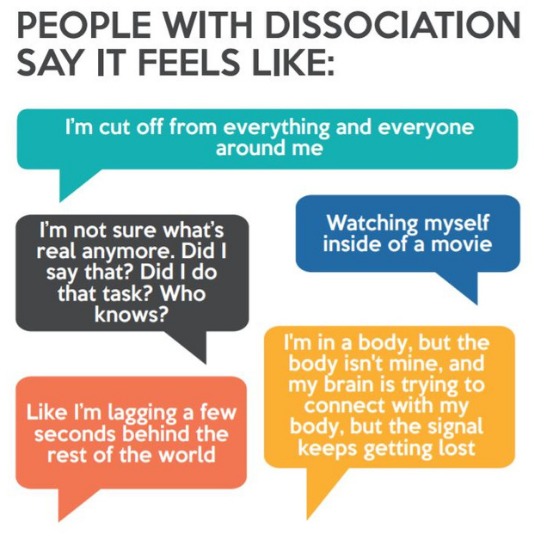
- Out-of-body experiences
- Feeling like you’re a different person sometimes
- Feeling emotionally numb or detached
- Having an altered sense of time
- Trouble remembering personal details
- Forgetfulness about things you’ve said or done
TYPES OF DISASSOCIATIVE DISORDERS
- Dissociative Identity Disorder
- Dissociative Amnesia
- Depersonalization/ Derealization Disorder
- Other Specified Dissociative Disorder
- Unspecified Dissociative Disorder
Paranoia and Delusion
SIGNS AND SYMPTOMS OF PARANOIA AND DELUSIONS
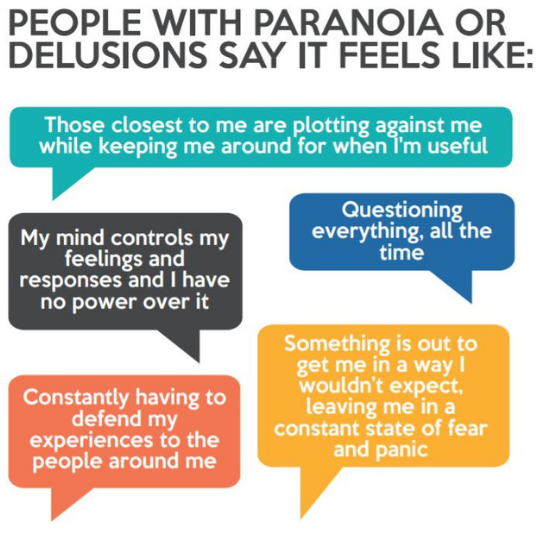
When a person has paranoia or delusions, but no other symptoms (like hearing or seeing things that aren’t there), they might have what is called a delusional disorder. Because only thoughts are impacted, a person with delusional disorder can usually work and function in everyday life, however, their lives may be limited and isolated.
People who have delusional disorder may have all or some of the following signs and
symptoms:
- Intense and irrational mistrust or suspicion
- Hypervigilance
- Difficulty with forgiveness
- Defensive attitude in response to imagined criticism
- Preoccupation with hidden motives
- Fear of being deceived or taken advantage of
- Inability to relax
- Being argumentative
Seasonal Affective Disorder (SAD)
SIGNS AND SYMPTOMS OF SAD
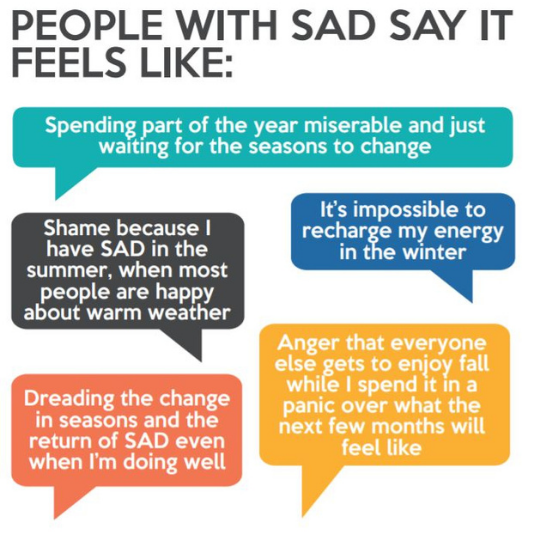
- DEPRESSION: Misery, guilt, loss of self-esteem, hopelessness, diminished interest in activities, despair, and apathy
- ANXIETY: Tension and inability to tolerate stress
- MOOD CHANGES: Extremes of mood and, in some, periods of mania in spring and summer
- SLEEP PROBLEMS: Oversleeping and difficulty staying awake or, sometimes, disturbed sleep and early morning waking
- LETHARGY: Fatigue and inability to carry out normal routines
- OVEREATING: Cravings for starchy and sweet foods resulting in weight gain
- SOCIAL PROBLEMS: Irritability and desire to avoid social contact
- SEXUAL PROBLEMS: Loss of libido and decreased interest in physical contact
Back to School 2021: Facing Fears and Supporting Students
Since we’ve been in the midst of a pandemic for a year and a half, it is difficult to remember how important feeling safe is to our mental health. But safety is vital, and if needs like safety aren’t met, a mental health condition may develop.
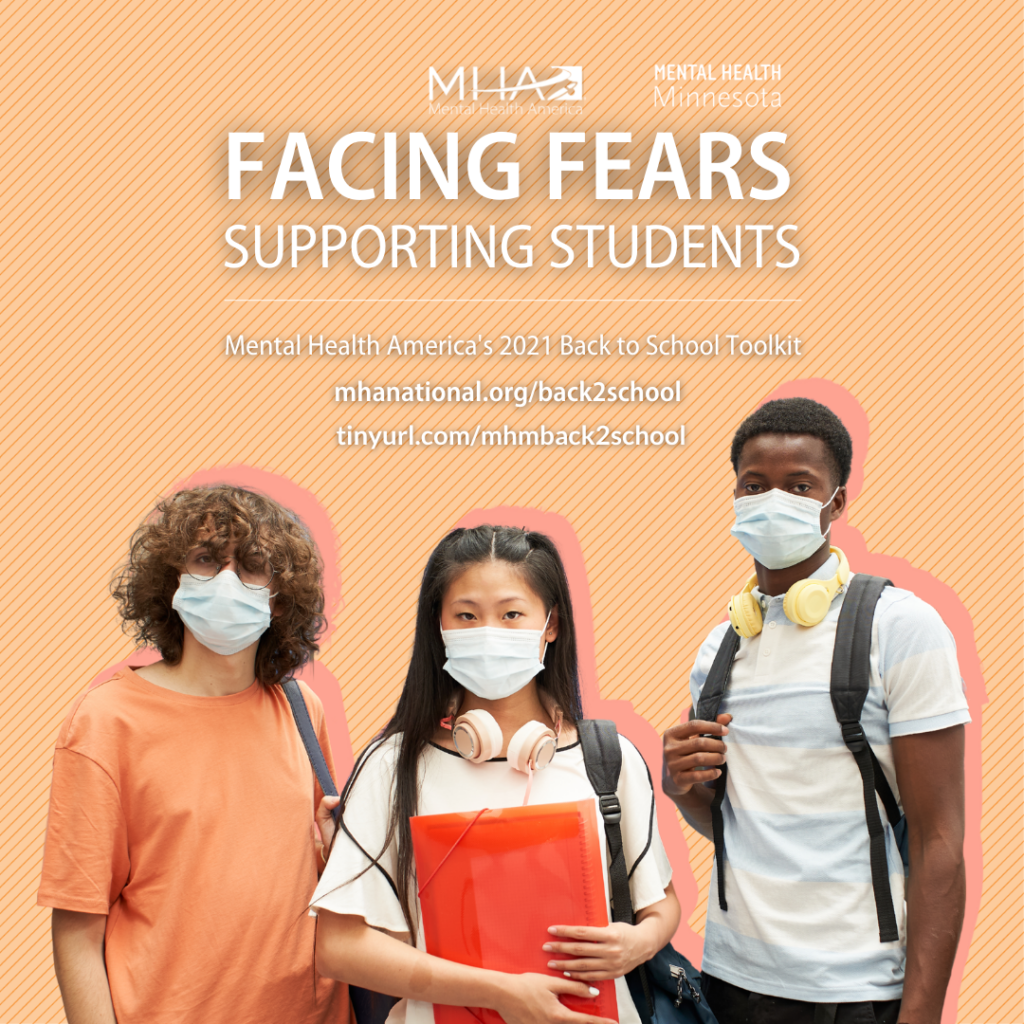
A lot of kids and teens haven’t been able to feel that sense of safety for a long time. Not only are they dealing with fears that a family member (or they themselves) might be exposed to COVID-19 or the Delta Variant, but some have had to face an abusive home environment, a family financial hardship, or a family loss recently. We know from research that an estimated 1.5 million children worldwide lost a mother, father, or other caregiving relative in the first 14 months of the pandemic.
When a kid or teen experiences this kind of hardship, it can feel as if the world is crashing down on them. That’s why it’s crucial right now, as students return to school, for parents, teachers, and administrators to do everything they can to foster a safe and secure environment. School can be a refuge from some of these difficult situations at home, and a place that students feel out of harm’s way.
Still, even in the safest of environments, we are in a youth mental health crisis, and many students will exhibit symptoms of depression and anxiety as they return to the classroom. It is important to let kids and teens know that support is available. Each school has different types of education and counseling services, so it is best to become familiar with the resources that your school provides.
To take an initial mental health screening, students can access www.MHAScreening.org for a free, confidential, and anonymous mental health test.
There are also serious signs that someone is in crisis and needs more immediate help. These include thoughts or plans of hurting oneself or another person. If you think a child or teen is in immediate danger of taking suicidal action, call the national suicide hotline at 1-800-273-TALK.
At Mental Health Minnesota, we also have free mental health support resources available to help children, families and adults get support #B4stage4 or before a crisis:
- Minnesota Warmline – Certified Peer Support Specialists offer free support to anyone struggling with mental health concerns
- Mental Health Helpline – mental health resource, information and local provider referrals
- 833-HERE4MN – licensed mental health providers offer free support to anyone struggling during the pandemic
Mental Health America‘s Back to School Fact Sheets
July is Black, Indigenous, and People of Color (BIPOC) Month
We are proud to celebrate BIPOC Mental Health Month this July as we come together to highlight this year’s theme “Strength in Communities.” This month we explore alternative mental health supports created by BIPOC and queer and trans-BIPOC (QTBIPOC) communities of color.
These community-developed systems of support fill gaps within mainstream healthcare systems: community care, self-directed care, and culturally-based practices. We’ll explore why these types of care are valid and valuable choices people can make for their mental health.
We are all unique individuals and communities so it is important that we address our specific needs when it comes to mental health. There is no universal or one-size-fits-all practice.
Community care
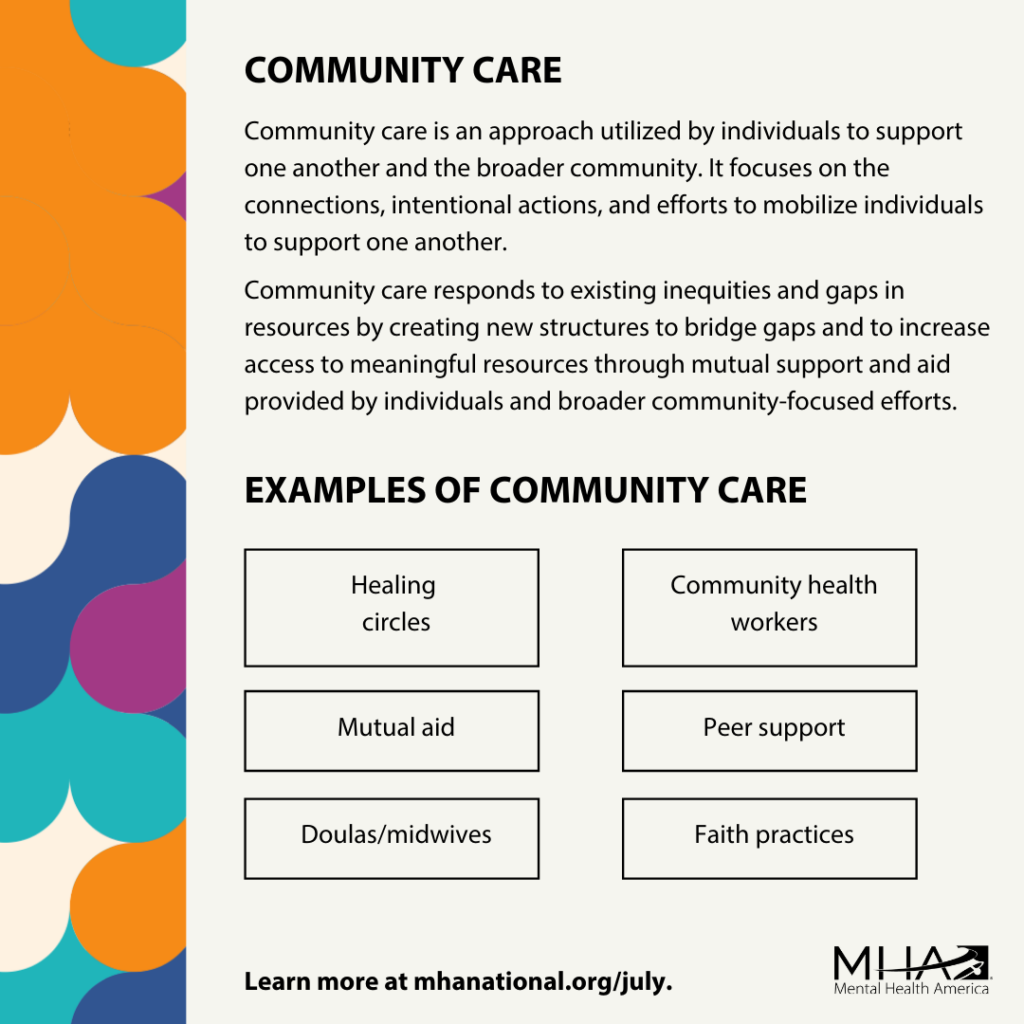
Community care is an approach used by individuals to support one another and the broader community. For BIPOC and QTBIPOC communities, it can be hard to find mental health care that respects and caters to their needs. In an effort to help provide care for these individuals who may have not found mental health support, communities are creating spaces on their own. These spaces provide healing within communities that understand them better, and the well-being of the individual is intrinsically tied to the well-being of others, including the larger community. Community care focuses on the connections, intentional actions, and efforts to mobilize individuals to support one another.
As a result, community care responds to existing inequities and gaps in resources by creating new structures to bridge gaps and to increase access to meaningful resources through mutual support and aid provided by individuals and broader community-focused efforts.
Examples of community care include Peer Support, which refers to someone who shares the experience of living with a mental health condition or substance use disorder. The peer-to-peer approach is important to mental health recovery and wellness, and that’s why we have certified peer specialists who run our Minnesota Warmline.
Self-directed care
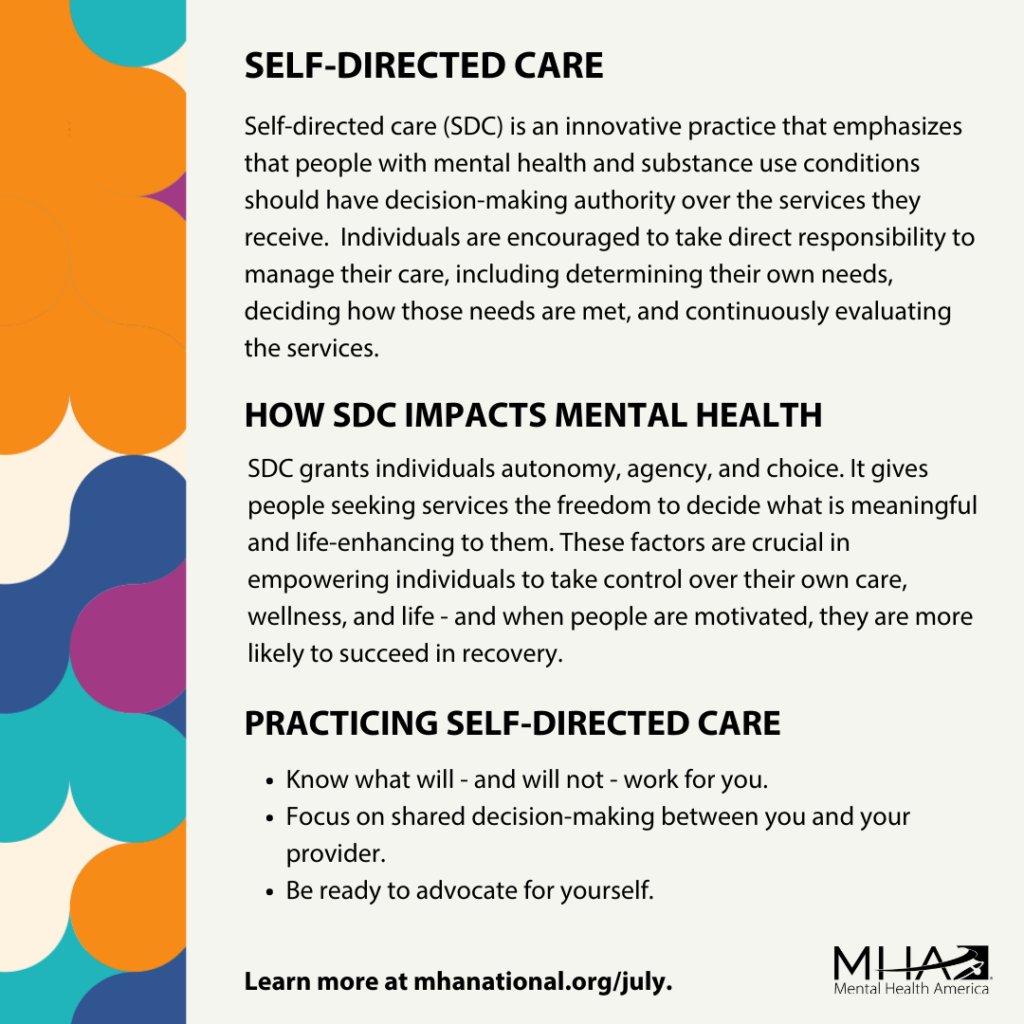
Self-directed care (SDC) is an innovative practice that emphasizes that people with mental health and substance use conditions should have decision-making authority over the services they receive. Individuals are encouraged to take direct responsibility to manage their care, including determining their own needs, deciding how those needs are met, and continuously evaluating the services.
The way people talk about and experience mental health is uniquely shaped by their racial/ethnic backgrounds and cultural experiences. Because SDC gives the individual seeking services the power to decide what works best for them, it allows people from marginalized communities to determine their own priorities in recovery and move beyond traditional systems of care, which weren’t originally designed with them in mind.
Our Mental Health Helpline can be your first source of SDC. Reach out via our online chat or by phone to get connected to information about mental health programs and services that might help you or a loved one.
Culturally-based practices
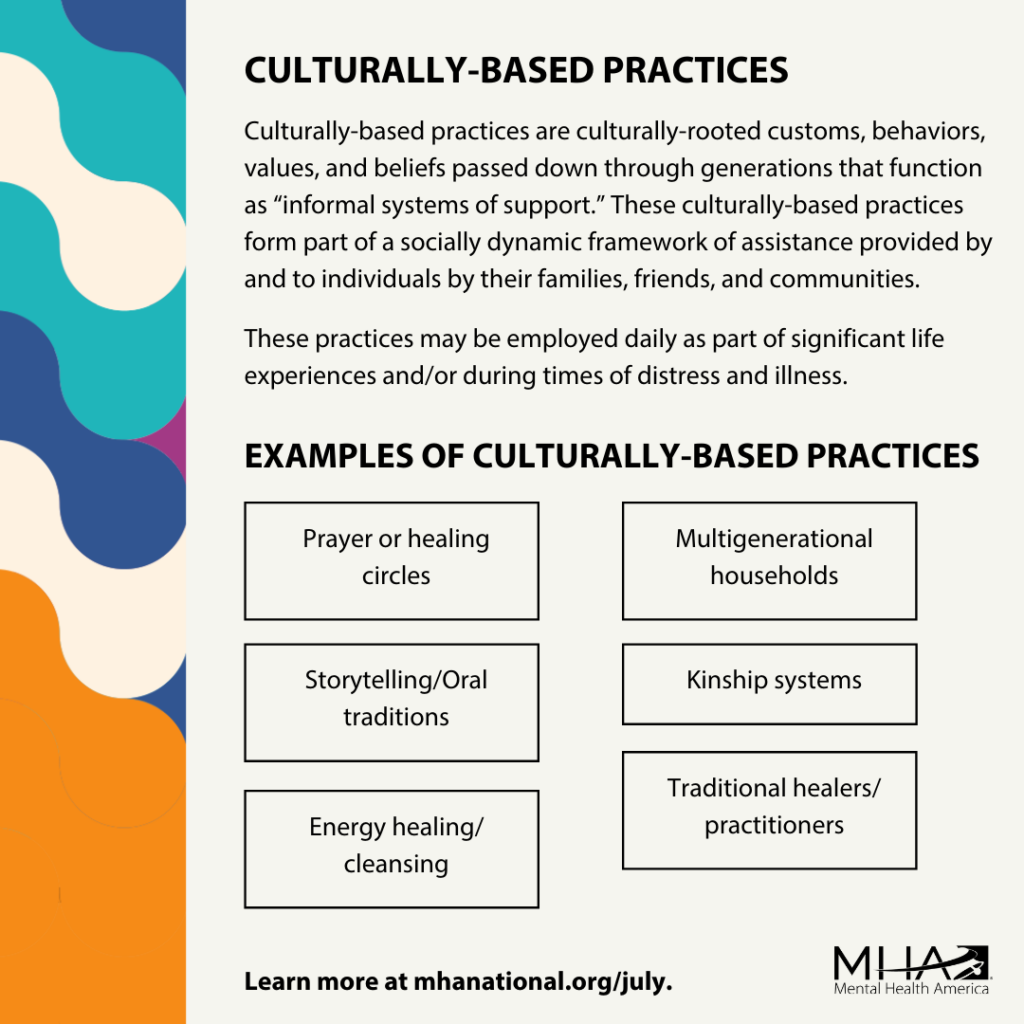
Culturally-based practices are culturally-rooted customs, behaviors, values, and beliefs passed down through generations that function as “informal systems of support.” These culturally-based practices form part of a socially dynamic framework of assistance provided by and to individuals by their families, friends, and communities.
For generations, culturally-based practices have been erased, set aside, hidden away, or utilized in secret.
However, it is important to shed light on and engage in culturally-based practices in order to heal. By learning about and embracing culturally-based practices, individuals and communities can begin the process of understanding the impacts of historical trauma, reclaiming the honor and pride of their ancestors, their historical knowledge, and the power that exists in connecting with one’s community through shared values, beliefs, and customs.
Source: Mental Health America
BIPOC Resources
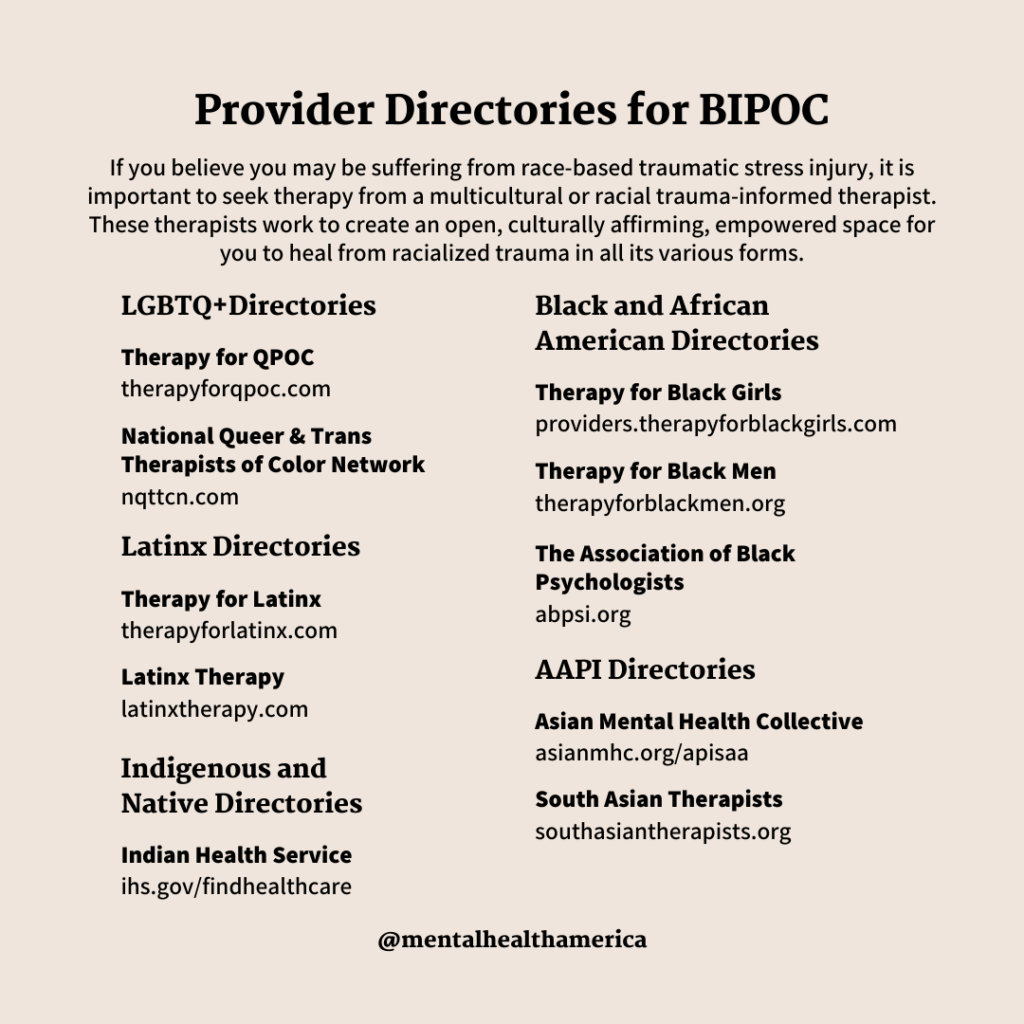
GENERAL MENTAL HEALTH RESOURCES FOR BIPOC
- BIPOC Mental Health
- Infographic: BIPOC And LGBTQ+ Mental Health
- Health Care Disparities Among Black, Indigenous, And People Of
- Color
- BIPOC Communities and COVID-19
- Racial Trauma
- Racism and Mental Health
- How To Find an Anti-Racist Therapist
- Is My Therapist Being Racist?
- I Have Trauma From Racism
- I’m Angry About the Injustices I See Around Me
BLACK AND AFRICAN AMERICAN COMMUNITIES
- Black and African American Communities and Mental Health
- Black Pioneers In Mental Health
- Bipolar Disorder And Black Americans
- Depression In Black Americans
LATINX/HISPANIC COMMUNITIES
- Latinx/Hispanic Communities and Mental Health
- Información Y Materiales De Salud Mental En Español (Information
- and Materials for Mental Health in Spanish)
ASIAN AMERICAN AND PACIFIC ISLANDER COMMUNITIES
NATIVE AND INDIGENOUS COMMUNITIES
LGBTQ+ COMMUNITIES
May is Mental Health Month

This past year presented so many different challenges and obstacles that tested our strength and resiliency. The global pandemic forced us to cope with situations we never even imagined, and a lot of us struggled with our mental health as a result. The good news is that there are tools and resources available that can support the well-being of individuals and communities.
Now, more than ever, we need to combat the stigma surrounding mental health concerns. That’s why this Mental Health Month Mental Health Minnesota is highlighting #Tools2Thrive – what individuals can do throughout their daily lives to prioritize mental health, build resiliency, and continue to cope with the obstacles of COVID-19.
Throughout the pandemic, many people who had never experienced mental health challenges found themselves struggling for the first time. During the month of May, we are focusing on different topics that can help process the events of the past year and the feelings that surround them, while also building up skills and supports that extend beyond COVID-19.
We know that the past year forced many to accept tough situations that they had little to no control over. If you found that it impacted your mental health, you aren’t alone. In fact, of the almost half a million individuals that took the anxiety screening at Mental Health Minnesota’s online screening, 79% showed symptoms of moderate to severe anxiety. However, there are practical tools that can help improve your mental health. We are focused on managing anger and frustration, recognizing when trauma may be affecting your mental health, challenging negative thinking patterns, and making
time to take care of yourself.
It’s important to remember that working on your mental health and finding tools that help you thrive takes time. Change won’t happen overnight. Instead, by focusing on small changes, you can move through the stressors of the past year and develop long-term strategies to support yourself on an ongoing basis.
A great starting point for anyone who is ready to start prioritizing their mental health is to take a mental health screening at our online screening site. It’s a quick, free, and confidential way for someone to assess their mental health and
begin finding hope and healing.
Ultimately, during this month of May, we want to remind everyone that mental illnesses are real, and recovery is possible. By developing your own #Tools2Thrive, it is possible to find balance between life’s ups and downs and continue to cope with the challenges brought on by the pandemic.
Free Support for Your Mental Health
- Minnesota Warmline – Certified Peer Support Specialists offer free support to anyone struggling with mental health concerns
- Mental Health Helpline – mental health resource, information and provider referrals
- 833-HERE4MN – licensed mental health providers offer free support to anyone struggling during the pandemic
Mental Health Month #Tools2Thrive Resources
- Tools2Thrive: FACT SHEET Accepting Reality (PDF)
- Tools2Thrive: FACT SHEET Adapting After Trauma and Stress (PDF)
- Tools2Thrive: FACT SHEET Dealing with Anger and Frustration (PDF)
- Tools2Thrive: FACT SHEET Getting Out of Thinking Traps (PDF)
- Tools2Thrive: FACT SHEET Processing Big Changes (PDF)
- Tools2Thrive: FACT SHEET Taking Time for Yourself (PDF)
- Tools2Thrive: WORKSHEET Dealing With Change (PDF)
- Tools2Thrive: WORKSHEET Dealing with the Worst-Case Scenario (PDF)
- Tools2Thrive: WORKSHEET Managing Frustration and Anger (PDF)
- Tools2Thrive: WORKSHEET Practicing Radical Acceptance (PDF)
- Tools2Thrive: WORKSHEET Prioritizing Self-Care (PDF)
- Tools2Thrive: WORKSHEET Processing Trauma and Stress (PDF)
Happy New Year (and Thank You!) from Mental Health Minnesota
What a year 2020 has been…a year of extraordinary challenges and significant hardship and stress for so many due to the pandemic that has seemingly overtaken everything else in the world.
However, we have also seen more people talking about mental health than ever before, as we all see the impact that isolation, loneliness, stress, anxiety, and depression can have on our own lives, on our families, our employment, our overall health and wellness, and so much more.
At Mental Health Minnesota, that has led to a significant increase in our services. More than 20,000 people completed our online mental health screenings in 2020 (half of those were completed in the last three months). Use of our Mental Health Helpline, which provides information and referrals, has doubled since 2019. And people are calling our Minnesota Warmline for peer support in record numbers as well, with more than 13,000 calls and texts in 2020.
During this time of extraordinary challenges, we also saw an interest from those who want to help us move our mission forward. In 2020, we have a number of volunteers help make calls to connect with people who were socially isolated and struggling, and 100+ volunteer mental health professionals who have given their time to provide mental health support to health care workers, essential workers, teachers, parents, and others facing unprecedented stress.
In addition, we received increased or new grant support from Otto Bremer Trust, Blue Cross Blue Shield. ICare, FEMA/Minnesota Department of Human Services, Kohl’s Community Cares Program and both Dakota and Ramsey Counties. The financial support along with the generosity of donors, helped us ensure that we could meet the increased demand for our mental health services and supports in Minnesota.
As we close 2020, I want to thank everyone who has been a part of Mental Health Minnesota’s work this year. Whether you were a phone line volunteer or event attendee, whether you shared your story of recovery to help others, or connected someone in your life to our services, whether you held a Facebook fundraiser or made a donation to support our work – I thank you. I truly humbled by the generosity of our grant partners, collaborators, donors, and volunteers. I look forward to continuing our work together as we move into the next year. May we all look forward to brighter days ahead.
With gratitude,
Shannah Mulvihill, MA, CFRE
Executive Director, Mental Health Minnesota
New Law Creates 988 Hotline For Mental Health Emergencies
Even prior to the pandemic, America was experiencing rising rates of suicide. According to the Centers for Disease Control, the suicide rate has climbed nearly 30 percent since 1999. The rate has also increased in 49 out of 50 states over the last ten years.
People experiencing a mental health crisis who do not need an immediate trip to the hospital often find they can receive more targeted support through crisis hotlines than by dialing 9-1-1. Crisis hotlines, such as the National Suicide Prevention Lifeline, can connect a person to a trained counselor who can address their mental health needs and help connect them to ongoing care. However, when in immediate need of support, remembering the digits of a long 1-800 number isn’t easy nor is it as accessible, especially when every second counts.
That’s why we are excited to see the federal government pass a law this October to approve the Federal Communications Commission’s three-digit number – 988 – for a mental health crisis hotline. The aim is to have the number up and running by July 2022.
With an easy to remember and dial number like 988, our nation can reach many more people in emotional crisis, helping meet the growing need for intervention at scale. Having an accessible number like 988 will also help in the fight to end stigma for those seeking mental healthcare.
Until the number is up and running, please continue to contact your county crisis team if you need help, or call the National Suicide Prevention Lifeline at 800-273-TALK (8255).
